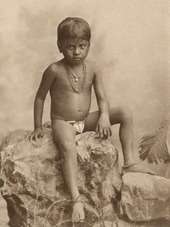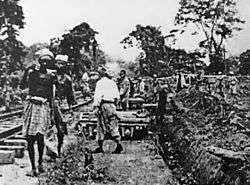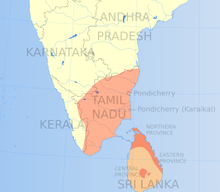Tamil Malaysians
.jpg) A group of Tamil people in British Malaya, 1898. | |
| Total population | |
|---|---|
|
Approximately 1,897,000 (>90% of Malaysian Indians) | |
| Regions with significant populations | |
|
| |
| Languages | |
| Tamil, English and Malaysian | |
| Religion | |
| Hinduism, Christianity, Buddhism, Islam | |
| Related ethnic groups | |
| Tamil, Tamil Muslim, Indian Singaporeans, Sri Lankan Tamil, Dravidians |
Tamil Malaysians, also known as Malaysian Tamils, are people of full or partial Tamil descent (from paternal descent) who were born in or immigrated to Malaysia from Tamil Nadu in South East India and the Tamil regions of northern Sri Lanka that is being presently administered the government of Sri Lanka. They make up over 90% of the Malaysian Indian populations in Malaysia. The bulk of Tamil Malaysian migration began during the British Raj, when Britain facilitated the migration of Indian workers to work in plantations. There are also, however, some established Tamil communities spanning a millennium.[1][2]
Precolonial period

Relations between Tamils and Malaysia have existed for more than 2000 years. The ancient Tamil poetic work Paṭṭiṉappālai refers to the territory of modern Malaysia as Kaalagam (Tamil: காழகம்).[3][4]
Tamil literature from the 10th and 11th centuries refers to the modern Malaysian state of Kedah as Kadaram (Tamil: கடாரம்)
Prior to British colonization, Tamils had been conspicuous in the archipelago much earlier, especially since the period of the powerful South Indian kingdom of the Cholas in the 11th century. The Pallava dynasty of Tamil Nadu spread Tamil culture and the Tamil script to Malaysia.[5] The Tamil emperor Rajendra Chola I of the Chola dynasty invaded Malaysia in the 11th century.[6]
The Malay Peninsula had a strong Tamil culture in the 11th century, and Tamil merchant guilds were established in several locations.[7] By that time, Tamils were among the important trading peoples of maritime Asia. Although the bulk of these immigrants to South East Asia had assimilated with the majority Malay ethnic group, some communities such as the Malacca Chittys are remnants of the earlier migration history.[8]
Colonial period

During the British colonial era, Britain facilitated the migration of Indian workers to work in plantations. The overwhelming majority of migrants from India were ethnic Tamil and from the Madras Presidency of the British Empire.
The Sri Lankan Tamils, also known locally as Ceylonese Tamils, were employed principally in the civil and professional services.
Tamil Indian freedom fighters Maruthu Pandiyar relatives and 72 soldiers were deported to Penang in the year 1802 by the Madras Presidency Government (British India Government). [9]
Siam Burma Death Railway

During the WWII Japanese army used more than 120,000 Tamils in the construction of 415 KM railway between Siam and Burma to transport them army supplies. During this project half of them (around 60,000) perished.
The recent research reveals that close to 150,000 Tamils perished during the project. The fell victim to snakes and insects, cholera, malaria and Beriberi. Some of them committed suicide, unable to bear the burden and the Japanese torture. [10]
| Part of a series on |
| Tamils |
|---|
 |
Language
Tamil is an educational language in Malaysia, with more than 500 Tamil medium schools. According to Harold Schiffman, an American researcher into Malaysian Tamils, compared to Singapore, language maintenance is favorable in Malaysia. However, he notes some Tamils are shifting to English and Malay.[11] Although most Tamil students still go to publicly funded schools that teach primary subjects in Tamil language there are moves to shift to Malay language. Tamil groups have seriously objected to this policy.[12]
Economic condition
Malaysian Tamils have had an opportunity to integrate with the expanding economy of Malaysia since 1970 under the New Economic Policy (NEP). Although the bulk of them still remain as workers in the plantation sector in rubber and palm oil estates at those times very many have moved out as blue collar and white collar workers in the expanding industrial sector. They are also found in civil service, professional sector, media and finance. One of Malaysia's wealthiest men Ananda Krishnan is a Malaysian Tamil origin. Overall it is one of the dynamic communities compared to other Indian diaspora groups such as in Fiji, Guyana and Trinidad and Tobago.[1]
Political condition
The Malaysian political process is based on a cooperative political alliance of three major political parties, each representing an ethnic community. Malaysian Indian Congress (MIC) represents the interests of the Malaysian Indian community at the federal level. Due to overwhelming natural presence, Malaysian Tamils have come to dominate the MIC since its inception. Samy Vellu, who is the longest serving leader of a mainstream Malaysian political party, having been MIC president since October 12, 1979 is a Malaysian Tamil, as are many of the office bearers of the party. In recent times the underclass of the Indian community have been galvanized by the Hindu Rights Action Force (HINDRAF) to fight for their rights. HINDRAF was classified as an illegal organization on 15 October 2008 and most of its top leaders have been detained under the Internal Security Act (ISA). In July 2018 Malaysian police launched a probe into P. Ramasamy's, deputy chief minister of Penang, alleged ties to LTTE.[13]
Notable people
This is a list of notable Tamil Malaysian people. Entries on this list have a linked current article which verifies that they define themselves as Tamil Malaysia, whose ethnic origins lie in Tamil Nadu or Sri Lanka (Ceylon).
- S.A. Ganapathy, trade unionist and Malaya freedom fighter
- P. Veerasenan, trade unionist and Malaya freedom fighter
- Tun Ali of Malacca, ancient ruler of Malacca
- Tun Mutahir of Malacca, 7th Bendahara of the Sultanate of Malacca
- Tun Fatimah, Malaccan politician; wife of Mahmud Shah of Malacca
- K. Thamboosamy Pillay, businessman; founder of Batu Caves and Sri Mahamariamman Temple
- V. T. Sambanthan, one of the founding fathers of Malaysia
- R. G. Balan, Malaya freedom fighter
- Sybil Kathigasu, Malaysian freedom fighter
- P. Uthayakumar, lawyer and ruman rights activist
- Waytha Moorthy Ponnusamy, lawyer and human rights activist
- Ananda Krishnan, businessman
- G. Gnanalingam, businessman
- Vinod Sekhar, businessman
- S. Vanajah, finalist of the Malaysian space program (Angkasawan program)
- K. Thanabalasingam, Rear Admiral (Rtd), Royal Malaysian Navy
- Ramon Navaratnam, economist and former Secretary-General of Ministry of Transport
- B. C. Shekhar, scientist; modernised Malaysia’s natural rubber industry
- Shan Ratnam, scientist, obstetrics and gynaecology
- R. Arumugam, Malaysian football player
- M. Viatilingam, Malaysian football player
- P. Dharmalingam, Malaysian football player
- K. Rajagopal, Malaysian football manager
- B. Sathianathan, Malaysian football manager
- Thirumurugan Veeran, Malaysian football player
- Punch Gunalan, Malaysian badminton player
- Renuga Veeran, Australian badminton player
- Ramasamy Palanisamy, deputy chief minister of Penang state
- Subramaniam Sathasivam, Minister of Health
- G. Palanivel, former Minister of Natural Resources and Environment
- Samy Vellu, former Minister of Works, and former Minister of Energy, Telecommunications and Posts
- V. Manickavasagam, former Minister of Telecommunications
- M. Magendran, first Malaysian to conquer Mount Everest
- N. Mohanadas, second Malaysian to conquer Mount Everest
- David Arumugam, singer
- Loganathan Arumugam, singer
- Dhilip Varman, musician, singer, and lyricist
- Jaclyn Victor, singer, actress
- Sabrina Beneett, Miss Universe Malaysia 2014
- Ambiga Sreenevasan, lawyer and human rights advocate
See also
References
- 1 2 Culture and economy:Tamils in the plantation sector 1998-99 (April 2000)
- ↑ Ethnic identity and News Media preference in Malaysia Archived 2007-08-28 at the Wayback Machine. (November 2006)
- ↑ திருநாவுக்கரசு, க.த., தென்கிழக்காசிய நாடுகளில் தமிழ்ப்பண்பாடு, p. 294.
- ↑ Pathinenmaelkanakku (PDF). Paṭṭiṉappālai (பட்டினப் பாலை) (in Tamil). Tamil Nadu. 100 BCE – 100 CE. p. 294.
|first1=missing|last1=in Authors list (help); Check date values in:|year=(help) - ↑ Prehistory of the Indo-Malaysian Archipelago by Peter Bellwood p.137
- ↑ Studies in Southeast Asian Art: Essays in Honor of Stanley J. O'Connor by Stanley J. O'Connor,Nora A. Taylor p.196
- ↑ Southeast Asia: From Prehistory to History by Ian Glover p.247
- ↑ Sneddon, James (2003). The Indonesian Language: Its history and role in modern society. Sydney: University of South Wales Press Ltd. p. 73.
- ↑ சிவகங்கைச் சரித்திர அம்மானை. Madras Government Oriental Manuscripts Series No: 34
- ↑ "The real Kwai killed over 1.50 lakh Tamils". The Hindu. Aug 27, 2016. Retrieved Sep 21, 2016.
- ↑ Schiffman, Harold (1998-12-31). "Malaysian Tamils and Tamil Linguistic Culture". University of Pennsylvania. Retrieved 2007-08-27.
- ↑ Tong, YS (2006-12-23). "Tamil groups object to language-switch policy". Malaysiakini. Retrieved 2007-08-27.
- ↑ "Malaysian Cops Launch Probe Over Politician's Alleged Ties to Tamil Tigers". Retrieved 16 September 2018.
External links
| Wikimedia Commons has media related to Tamil Malaysians. |
